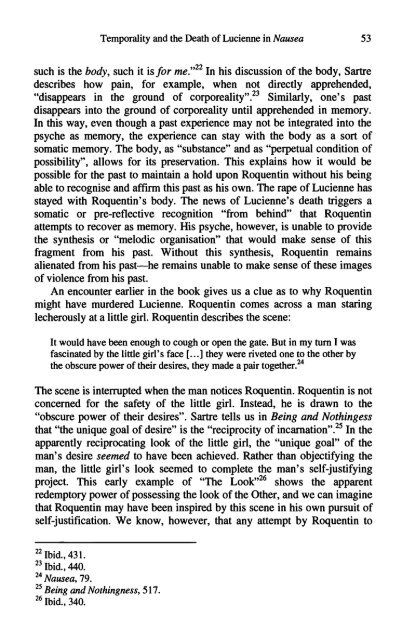Sartre's second century
Sartre's second century
Sartre's second century
Create successful ePaper yourself
Turn your PDF publications into a flip-book with our unique Google optimized e-Paper software.
Temporality and the Death of Lucienne in Nausea 53<br />
such is the body, such it is for me. In his discussion of the body, Sartre<br />
describes how pain, for example, when not directly apprehended,<br />
"disappears in the ground of corporeality". 23 Similarly, one's past<br />
disappears into the ground of corporeality until apprehended in memory.<br />
In this way, even though a past experience may not be integrated into the<br />
psyche as memory, the experience can stay with the body as a sort of<br />
somatic memory. The body, as "substance" and as "perpetual condition of<br />
possibility", allows for its preservation. This explains how it would be<br />
possible for the past to maintain a hold upon Roquentin without his being<br />
able to recognise and affirm this past as his own. The rape of Lucienne has<br />
stayed with Roquentin's body. The news of Lucienne's death triggers a<br />
somatic or pre-reflective recognition "from behind" that Roquentin<br />
attempts to recover as memory. His psyche, however, is unable to provide<br />
the synthesis or "melodic organisation" that would make sense of this<br />
fragment from his past. Without this synthesis, Roquentin remains<br />
alienated from his past—he remains unable to make sense of these images<br />
of violence from his past.<br />
An encounter earlier in the book gives us a clue as to why Roquentin<br />
might have murdered Lucienne. Roquentin comes across a man staring<br />
lecherously at a little girl. Roquentin describes the scene:<br />
It would have been enough to cough or open the gate. But in my turn I was<br />
fascinated by the little girl's face [...] they were riveted one to the other by<br />
the obscure power of their desires, they made a pair together. 24<br />
The scene is interrupted when the man notices Roquentin. Roquentin is not<br />
concerned for the safety of the little girl. Instead, he is drawn to the<br />
"obscure power of their desires". Sartre tells us in Being and Nothingess<br />
that "the unique goal of desire" is the "reciprocity of incarnation". 25 In the<br />
apparently reciprocating look of the little girl, the "unique goal" of the<br />
man's desire seemed to have been achieved. Rather than objectifying the<br />
man, the little girl's look seemed to complete the man's self-justifying<br />
project. This early example of "The Look" 26 shows the apparent<br />
redemptory power of possessing the look of the Other, and we can imagine<br />
that Roquentin may have been inspired by this scene in his own pursuit of<br />
self-justification. We know, however, that any attempt by Roquentin to<br />
22 Ibid., 431.<br />
23 Ibid., 440.<br />
24 Nausea, 79.<br />
25 Being and Nothingness, 517.<br />
26 Ibid., 340.
















